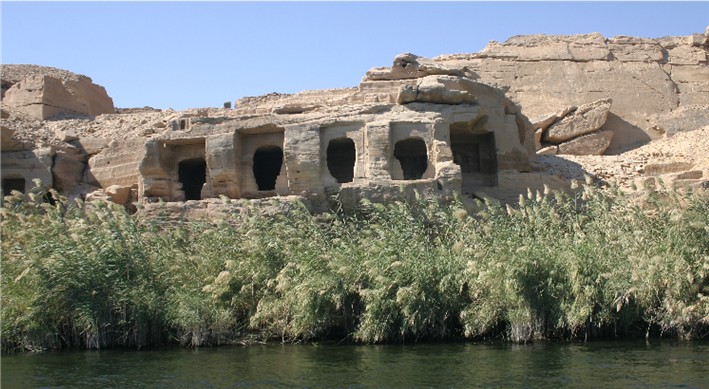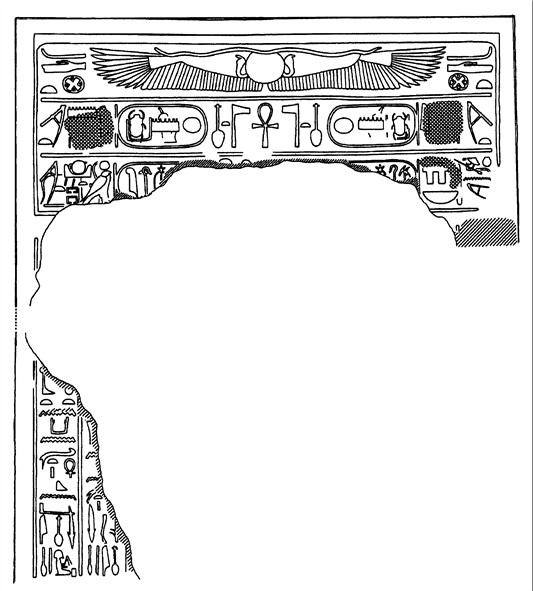| |
Shrine No. 13 |
last update:
26.03.2008
|
Data
| Shrine No. |
Name /
Transliteration |
Date |
Distance to the Speos of Haremhab
[~ m] |
Remarks |
| 13 |
Senneferi |
joined reign of Hatshepsut and Thutmosis III |
367 |
|
| All data according to Caminos, 1963 |

|
From right to left the shrines No.: 12 (Minnakhte), 13 (Senneferi), 14 (Nehesj),
15 (Hapuseneb), 16 (Senenmut), and - destroyed - 17 (User-amun), all built
during the reign of Hatshepsut and Thutmosis III (photo: E. Noppes). The
entrances of all shrines were set into shallow recesses formed by cutting back
the face of the rock. |

|
Drawing of the decoration of the front side of shrine Nr. 13 according to
Caminos (Caminos, 1963). |
|
The 1st register of the lintel shows the winged sun-disk (BHdtj).
As described by Caminos the 2nd registers carries the name of the king during
whose reign the shrine was built. ere both cartouches show the throne name of Thutmosis III, Men-kheper-Ra,
- however, both had been changed. The original name is quite well recognizable
in the left cartouche and reads -
Maat-ka-Ra (Hatschepsut). |
Furthermore, the complete inscription is dedicated to a female:
"
anx nTr.t nfr.t ... mr.t Imn-Ra
Life may be given to the Good Goddess ... beloved by Amun-Ra" |
|
Caminos suggested that when the name was changed to Men-kheper-Ra
the unnecessary t used to identify the female form were covered with
plaster. |
|
At the bottom of the left door jamb the title and the name of the owner,
"Overseer of the sealbearers, the valiant Senneferi, justified (jmj-rA sDAwt
onj %n-nfr.j mAa-xrw) ", have been preserved. |
|
The interior of the shrine consists of a single room, almost square (254x235 cm)
with a flat ceiling (about 190 cm above the floor). The walls had been
originally decorated with scenes and text but only a few fragments have been
preserved. On large areas of the walls the decoration has been scraped off
already in antiquity. In addition, the north and the south wall were damaged by
a doorways which were cut northwards into the adjoining shrine of Minnakhte
(shrine No. 12) and southwards into the shrine of Nehesy (No. 14). |
|
The west wall contains the usual statue-niche. The niche is about 144 cm high,
146 cm wide, and maximally 59 cm deep, the bottom starts about 10 cm above the
floor. The niche held to figures which are badly damaged and uninscribed.
However, the figure on the right should probably depict Senneferi and the one on
the left his wife Tajmau or Tiamu.
|
|
Occasionally, shrine No. 13 was used for dating Senneferi, i.e. the change in
the cartouches presented on the lintel was used as an attestation that he was
already active during the reign of Hatshepsut. The 2nd register shows the throne name of Thutmosis III, Men-kheper-Ra,
however, the cartouches had been obviously re-carved - the original name is
still recognizable in the left cartouche and reads - Maat-ka-Ra (Hatshepsut).
|
|
This interpretation is strictly rejected by Helck (GM 43, 1981). During the
reign of Hatshepsut two "Overseer of the sealbearers (jmj-rA sDAwt)"
are attested: Nehesj (leader of the journey to Punt; owner
of shrine No. 14 at Gebel
es-Silsilah) and Ty or Tai (&Aj) who is
still attested by an inscription on the Sinai until year 25 of Thutmosis III.
If Senneferi should have been active already under Hatshepsut then Senneferi and Tai must have been "Overseer of the sealbearers" at the
same time.
|
According to Helck it is nowhere attested that two officials carried out the
duties of an "Overseer of the sealbearers" concurrently. Helck argues
that since Ty is attested in year 25 of Thutmosis III and Senneferi in year 32
of that king (in a papyrus, Louvre E2336; quoted from Helck, GM 43, 1981) the
last one is the successor of Ty in that office.
Therefore, he assumes that Senneferi did not built shrine 13 but took over an abandoned
shrine during
the autocracy of Thutmosis III.
Furthermore, Helck points out to the fact
that shrine No. 13 is the only one in which the name of Hatshepsut was not only
erased but also replaced by that of Thutmosis III - in all other shrines which
were built during the reign of Hatshepsut, her name was only erased. The
replacement of the name of Hatshepsut by name of Thutmosis III is therefore an
unique event in comparison to the other 8 shrines.
|
|
Based on the considerations of Helck Senneferi should be counted as a
contemporary of Thutmosis III, a dating into the reign of Hatshepsut on account
of the changes done in shrine 13 at Gebel es-Silsilah appears untenable. |
|

